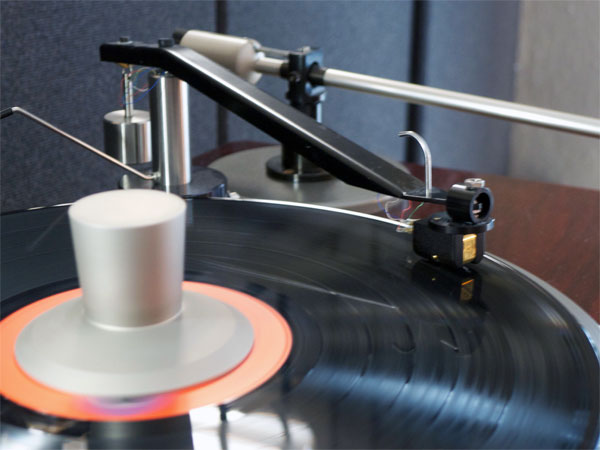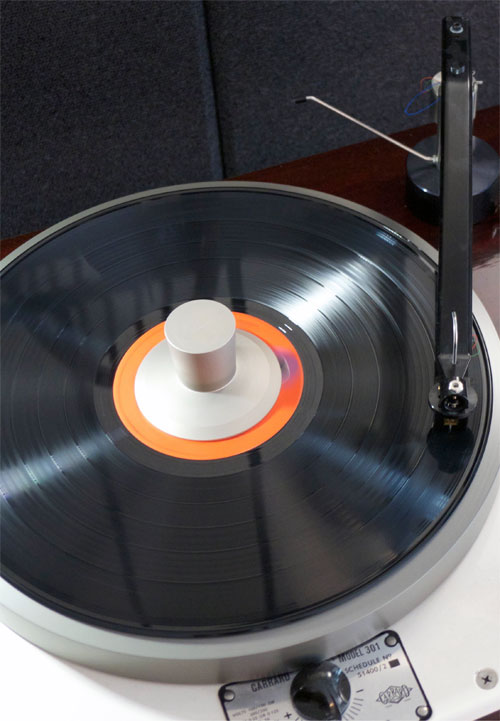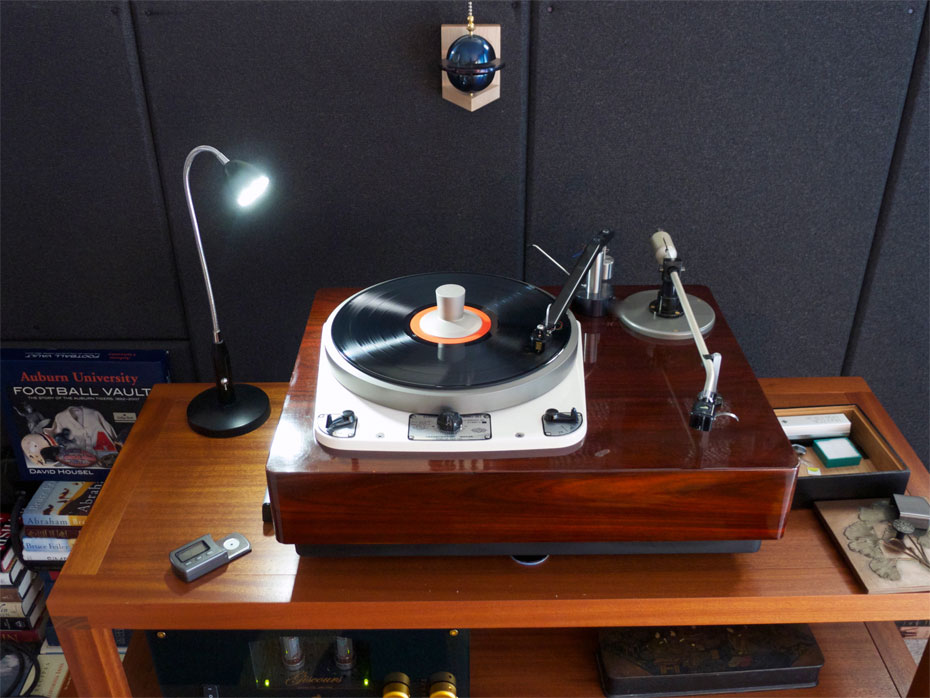You might ask why I would review a tonearm that has been on the market for quite some time. Well, the answer is simple: It’s a unique product, it fits the needs of certain cartridges, and it’s an outstanding bargain.
Description
Some people are scared to death of handling tonearms, and of course this is especially true of unipivot tonearms. If you fall into that camp the RS Lab’s tonearm has to be the scariest tonearm on the market. Not only is this arm scary as hell to use, it is also somewhat crude- and unusal-looking. For this reason even though the RS-A1 has been around a while it has never become a mainstream tonearm. However, if you’re brave and adventurous enough, I have no doubt that it will give you world-class sound for a bargain price.
The first thing that hits you when you look at the RS-A1 is that it doesn’t have anything remotely resembling a tonearm tube; instead it is a flat piece of aluminum with the sides bent in. The tonearm is also bent right in front of the pivot and comes downhill like a ski jump until it connects to a horizontal rotating headshell with the finger lift in the center, rather than the side, of the headshell.
If you carefully turn the arm over you will see the tonearm wires. They are the thinnest I have ever seen. These little wires are enclosed in a tunnel inside the arm and terminate in two RCA plugs at the bass of the arm. This flat arm sits on a downward facing brass bearing cup. The RS Lab’s unipivot design is basically like most unipivots with the bearing being machined from steel, and coming to a single sharp point that goes into the bearing cup assembly. The counterweight hangs about an inch behind and a little more than an inch below the bearing, thereby putting it in approximately the same plane as the headshell. There is a threaded brass screw that allows the counterweight to adjust the VTF. The base of the arm is pretty heavy and thus provides a solid foundation for the arm. This set up is another thing unique to this tonearm as far as I know; it should not to be mounted to an armboard, but just sits on the plinth.
If not having a tonearm tube, or having the world’s thinnest wires, or just sitting the arm on the plinth, and having the pivot point about an inch and a half above the record aren’t enough to set this arm apart, then there’s the headshell. The RS Lab uses a unique – at least to me – rotating headshell. The specs say the range of movement is six degrees in either direction, but it seems like a lot more in practice. It’s connected to the tonearm through the use of a simple needle bearing.
Design Philosophy
The RS Lab’s tonearm is based on the theory that the tonearm should be the mechanical earth to the vibration system, much like an electrical system in which the ground potential is the potential to which all others references are considered. To pick up the tone signal accurately from the disc, the support part of vibration system, including cartridge body, shell, arm and arm base, should not be moved relative to the vibration system.
The product page from the Sakura Systems website, U.S. importer of RS Labs, says, “most of today’s tonearms come with the offset angle to minimize tracking error. The distortion caused by tracking error can easily be explained geometrically and easy to solve geometrically by giving an offset angle to the arm, but the actual effect of the tracking error on the sound is less serious than that of the strong inside force caused by the offset angle. The inside force changes dramatically by the frequency and amplitude of the signal, and a static canceling system is not effective enough. Overly concerned on tracking error, arms with offset angle and forget the forest by just focusing on the tree. Straight arm has tracking error, but it is far less damaging to the signal than the strong inside force caused by the offset angle. .
Offset angle exists on vertical plane too, made by the angle of cantilever and horizontally flat arm setting, causing extra down force. Our tonearm compensates for this problem with a higher fulcrum setting, giving 16 degrees angle to the arm.”
Furthermore, RS Lab uses a rotary head shell designed to reduce needle talk that is “caused mostly by the cartridge-arm-base resonant chain. The rotary headshell of cuts off this chain of resonance by eliminating the effect of the arm mass to the cartridge.”
Setup & Auditioning
First, you need to ever so slowly and carefully remove the tonearm from its formed foam packaging. Be really careful at this early stage because the tonearm wires are quite fragile and you could easily rip them right off.
Next, you should mount the cartridge in one of the three threaded pairs of mounting holes on the headshell. It can be very frustrating figuring out which holes to use, but in the end I got everything I tried mounted. The instructions suggest that the easiest way to mount a cartridge is to turn the arm and base on its side rather than mounting the cartridge from above with the arm positioned on the plinth, which I found to be a very good advice.
Adjusting the azimuth at the headshell is not that hard but the method differs from that used for most tonearms. Basically, the finger lift should be left in its original position and barely moved enough to get the azimuth right. It is also important to be very careful in dressing the tonearm wires. Yes it’s a bit of a pain, but not an insurmountable problem. If there has ever been a tonearm that cries out for a good device for measuring azimuth, this is it. I used a Fosgate Fosgometer. Setting the rest of the geometry is easier than most tonearms, since you can move the bass around on your plinth to get the right geometry.
Of course the question has to be, does it sound good enough to be worth all this trouble? The answer is yes to some, maybe to many, and no to those who are skittish. Using several very good moving coil cartridges including the Miyabi Standard, the Miyajima Premium BE Mono, and the Allnic Verito Z, the RS Labs tonearm allowed my system to sound very immediate and powerful. It had very good transparency, detail, and PRaT, and a deep soundstage. It does all this without sounding bigger than life or overly fat. Music doesn’t flow quite as effortlessly as it does with the Shindo tonearm, but it doesn’t cost nearly as much as the Shindo. Both arms allow music to sound very smooth and very dynamic at the same time. No, the RS Labs does not sound quite as relaxed as the Shindo, but I don’t know another arm that does for any price. The RS Labs also lets the colors of music come through in a very vivid and beautiful way.
Conclusion
This arm does an amazing job of playing cartridges over a wide range of mass, and it works well with cartridges that need to be well controlled. Thus, it allows a wide range of cartridges to sound near if not their best. It is indeed a bargain for such a great sounding and versatile tonearm. Still, when it comes down to decision time the RS Labs Tonearm is not for the faint of heart. It requires an owner who isn’t afraid to deal with a lot of movement before you get the needle in the grove, but if you can handle that you’ll be very happy with the sound it brings forth from the grooves of those most loved LPs.
- (Page 1 of 1)



Hello
I recently required an RS1 arm, It mint with all 9or most parts intact. I noticed a small hanging wire
behind the main weight, with a variety of very small weights which probably are used for taking tracking. Do you know if I can purchase a set or the part? Is it important for set-up? I’m sure for re-sale. Can I contact the manufacturer for spare parts?
Thank You
Lorenzonium